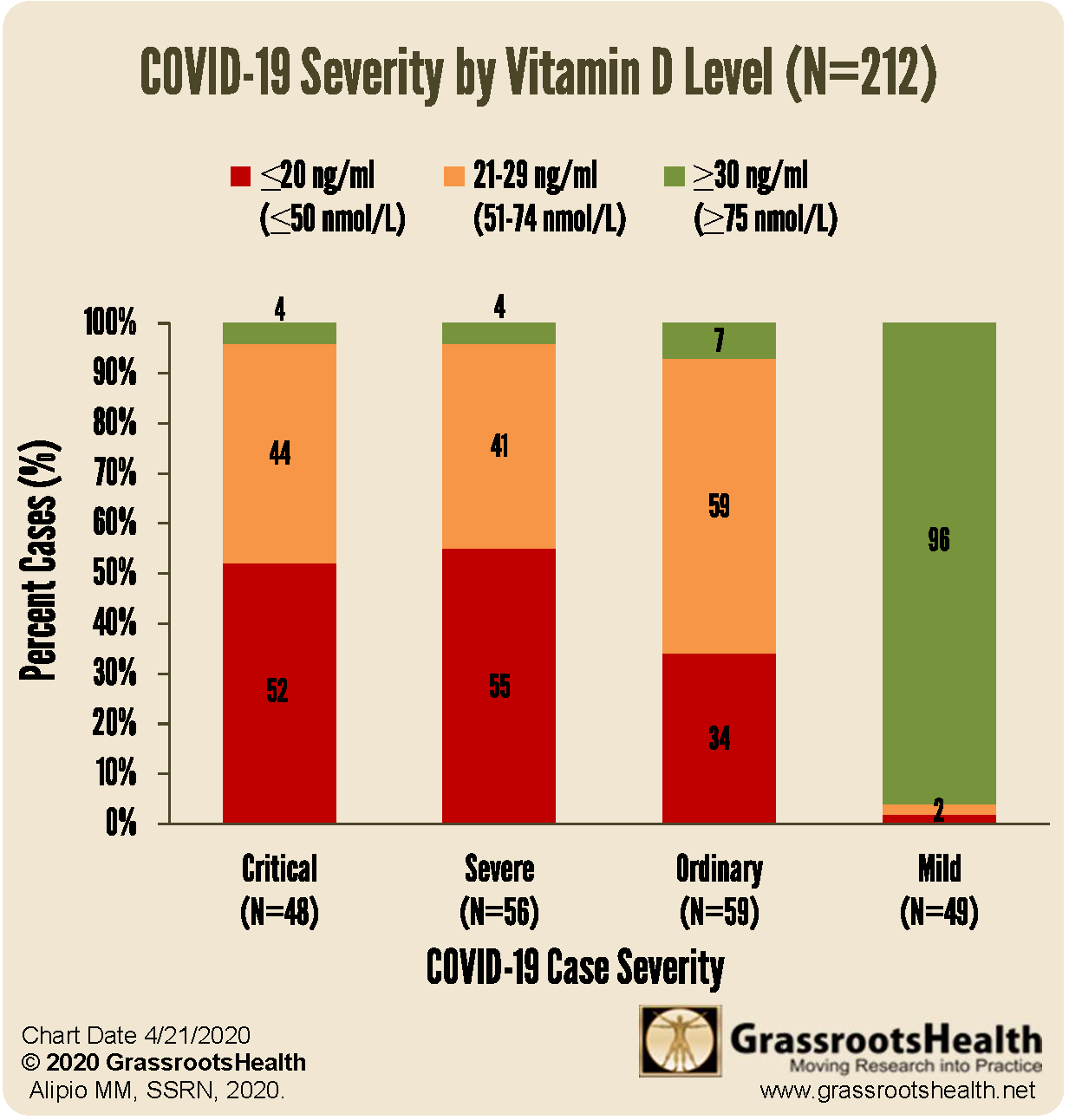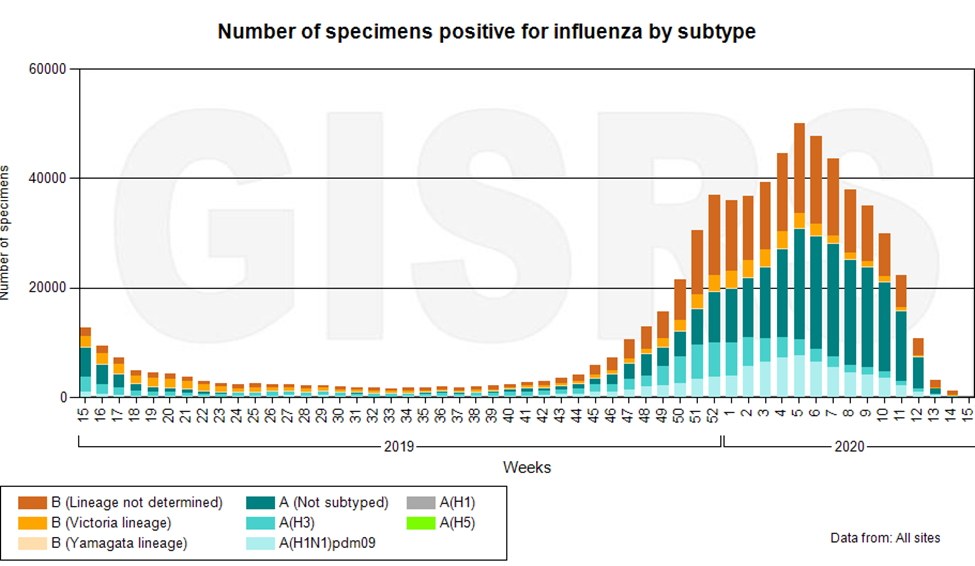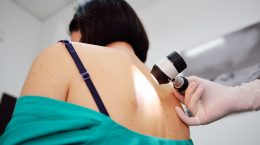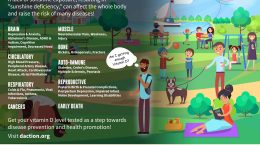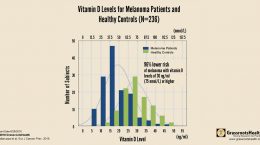Published on May 28, 2020
Sunlight and health, from the earliest human civilizations to our current battle with COVID-19, have an inseparable link. Dr. John Fielder’s exceptionally well-written paper, History of Heliotherapy provides insight into the past. Many ancients deified sunlight. The populations of those times had no doubt of its healing powers. Hippocrates, the Greek physician known as the “father of medicine,” recommended sunbathing and had his own large solarium-an enclosed area for sunning. This was also true of ancient Romans, whose thermae (hot tubs and baths) were equipped with solaria. The Roman philosopher Pliny wrote, “Sun is the best remedy.”
Sunlight and health maintained a link well into the 20th century.
 In the early 19th Century, scientists began to experiment with sun as a healer and were so impressed with their results they attempted to build a new system of therapeutics based on heliotherapy. In 1857, Madame Duhamel exposed children with TB to sunshine because it hastened their recovery. Many other doctors used heliotherapy with great success. Dr. Fielder states, “As a general rule, the experience of all the hygienists in their use of sunbathing was so successful all question of doubt as to its place in the hygienic system was ensured.”
In the early 19th Century, scientists began to experiment with sun as a healer and were so impressed with their results they attempted to build a new system of therapeutics based on heliotherapy. In 1857, Madame Duhamel exposed children with TB to sunshine because it hastened their recovery. Many other doctors used heliotherapy with great success. Dr. Fielder states, “As a general rule, the experience of all the hygienists in their use of sunbathing was so successful all question of doubt as to its place in the hygienic system was ensured.”
Though nothing has really changed regarding sunlight and health, doubts about the relationship have crept in.
In the early 20th Century, people noticed that farmers developed common skin cancers on their faces and hands. This news began the war on sunlight. Nevertheless, the sun held its own for some time, because research also showed sunlight had anti-cancer properties. This idea triggered a 1932 editorial in The Lancet medical journal suggesting sunlight was so effective in promoting health that the government should set aside public areas for nude sunbathing! (Dawson, Lord. Naked and Unashamed. Lancet 6, 1932:688.)
Then, it was decided, regrettably, that since common skin cancer was associated with sunlight, that sunlight must also cause melanoma, the deadly skin cancer. A new fear had been born, along with a new industry-sunscreen and medical profits. Even though moderate, regular sun exposure protects against melanoma, this fear vs fact-based decision launched an all-out assault on the sun. It continues today. Unfortunately, it has become ‘rewarding’ to the industry that provides tanning lotions and treatments for the cancers. More about this can be learned when viewing the video, Vitamin D: Skin Cancer/Sunscreen – the Dilemma, by Dr. Edward Gorham. Our efforts now are to display the physical and medical costs associated with that point of view.
To dispel the myths, here are the facts about melanoma:
- Seventy-five percent of melanomas occur on body areas seldom exposed to sunlight.
- In the U.S., as sun exposure has decreased by about 90% since 1935, melanoma incidence has increased by 3,000%. Documentation in Embrace the Sun. See the graph below.
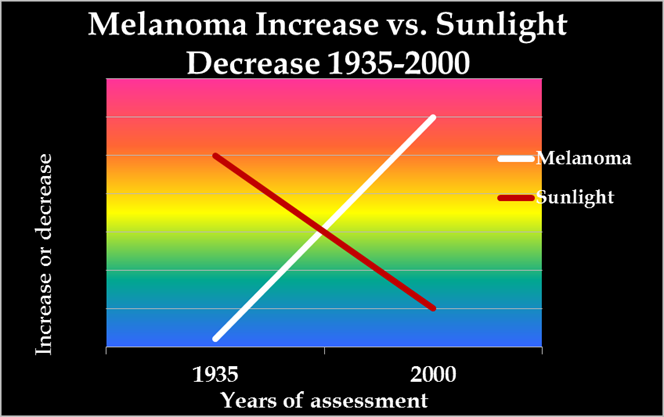
- As in the US, while sun exposure in Europe has profoundly decreased, there has been an exponential increase in melanoma.
- Men who work outdoors have about half the risk of melanoma as men who work indoors.
- Outdoor workers, while receiving 3-9 times the sun exposure as indoor workers, have had no increase in melanoma since before 1940, whereas melanoma incidence in indoor workers has increased steadily and exponentially.
- Sunscreen invention, along with its steadily increasing use, has not reduced the risk of melanoma. In fact, melanoma increased as sunscreen use increased. Documentation in Embrace the Sun.
- Increasing melanoma incidence significantly correlates with decreasing personal annual sunlight exposure.
- Outdoor workers do get numerous sunburns but still have a dramatically lower risk of contracting melanoma.
Thus, melanoma increases as sun exposure decreases. There is much need to provide the education and data to everyone so they can avoid blaming the sun.
Here are more facts about melanoma and its prevention:
- People in the highest quintile (fifth) of alcohol consumption have a 65% increase in melanoma risk.
- Weekly meat consumption may increase melanoma risk by 84%.
- Daily fruit consumption may reduce the risk of melanoma by nearly 50%.
- Persons with the highest levels of blood PCBs (now-banned industrial chemicals) have 7-times the risk of melanoma as those with the lowest levels.
- There is a positive association between melanoma and obesity. It is interesting that the increases in both diseases have progressed in unison.
- The highest number of new melanoma cases are in Utah, followed closely by Vermont, Minnesota and New Hampshire. By far the lowest number of new cases are in Texas.
So, since melanoma continues to increase in lock step with reduced sun exposure, should we continue to blame the sun?
We have destroyed the misconception that sunlight is a major cause of melanoma. Let us proceed to the magnificent health-protective effects of regular, non-burning sun exposure against other diseases:
- Recent research from Indonesia shows that COVID-19 patient deaths are approximately 20 times higher among those with vitamin D levels less than 20 ng/ml as those who have levels greater than 30 ng/ml. Had the researchers had a population of subjects whose vitamin D levels measured greater than 50 ng/ml, I would predict no deaths at all. The chart below, from GrassrootsHealth, is telling. Remember sun exposure to the body produces 90% of serum vitamin D levels (in non-supplementing individuals). Therefore, we see the profound effect sun exposure could have on COVID-19.
Indonesians have taken this research seriously. Below is a photo of Indonesian men “social distancing” in the sunlight.

Sunlight and Health: More facts regarding the influence of sun exposure on disease.
- Influenza diminishes almost to nothing during late spring, summer, and early fall – times of greatest sun exposure and vitamin D production. See the chart below, produced by the WHO and provided by Goran Olsson of Moscow, Russia. We don’t yet have annual data for COVID-19, a “flu-like” disease, but it did emerge in the northern hemisphere in winter when sun exposure and vitamin D levels are low.
- Women who sunbathe regularly may have half the risk of death, during a 20-year period, compared to those who stay indoors.
- A Spanish study shows that women who seek the sun have one-eleventh the hip-fracture risk as sun avoiders.
- Women who avoid the sun may have 10-times the risk of breast cancer as those who embrace the sun.
- Multiple sclerosis (MS) is highest in areas of little sunlight, and virtually disappears in areas of year-round direct sunlight.
- Sun exposure decreases heart disease risk through nitric oxide production.
- Sun exposure dramatically improves mood through production of serotonin and endorphin.
- Morning sun exposure resets the circadian rhythm, which synchronizes physical, emotional and mental processes and associates with lower cancer rates.
- Those persons who spend many hours daily outdoors have only 1/50 the risk of Parkinson’s disease.
- For each death caused by diseases associated with sun exposure, there are 328 deaths caused by diseases associated with sun deprivation.
- Sun exposure increases the production of BDNF (Brain-Derived Neurotrophic Factor), essential to nerve function.
- Sun exposure can produce as much as 20,000 IU of vitamin D in 20 minutes of full-body sun exposure.
- In England, vitamin D deficiency in children has increased by 83 times during a 14-year period. That is likely due to indoor living and sunscreen use.
Finally, as part of my analysis of sunlight’s positive powers, I, along with my coauthor, Dr. Bill Grant, performed an analysis of the number of deaths caused by diseases associated with high sun exposure. Then we performed another analysis of the number of deaths associated with diseases of sun deprivation. We then compared them. Here are the deaths for diseases of low sun exposure:
Diseases associated with low sun exposure in the USA
| Disease | Year | Deaths |
| Osteoporosis | 2005 | 71,280 |
| Osteoarthritis | 2004 | 500 |
| Rheumatoid arthritis | 1998 | 2,060 |
| Bladder cancer | 2016 | 16,390 |
| Brain cancer | 2016 | 16,050 |
| Breast Cancer | 2016 | 40,980 |
| Cervical cancer | 2016 | 4,074 |
| Colon cancer | 2016 | 49,190 |
| Endometrial cancer | 2016 | 10,470 |
| Gallbladder cancer | 2016 | 3,710 |
| Kidney cancer | 2016 | 14,240 |
| Lung cancer | 2016 | 158,080 |
| Leukemia | 2016 | 24,400 |
| Lymphoma | 2016 | 21,270 |
| Multiple myeloma | 2016 | 12,650 |
| Oral and pharyngeal cancer | 2016 | 9,570 |
| Ovarian cancer | 2016 | 14,240 |
| Pancreatic cancer | 2016 | 34,920 |
| Prostate cancer | 2016 | 26,120 |
| Thyroid cancer | 2016 | 1,980 |
| Cardiovascular disease | 2015 | 801,000 |
| Diabetes | 2010 | 69,071 |
| Crohn’s disease | 2004 | 825 |
| Asthma | 2010 | 4,000 |
| Influenza | 2010 | 36,000 |
| Pneumonia | 2016 | 53,282 |
| Septicemia | 2012 | 35,000 |
| HIV – AIDS | 2013 | 6,995 |
| Necrotizing fasciitis | 2010 | 200 |
| Tuberculosis | 2014 | 555 |
| COPD | 2009 | 145,575 |
| Total annual deaths, approximated | 1,684,677 |
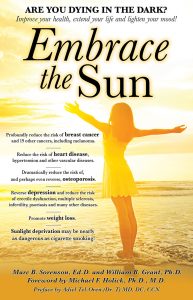
There were few deaths from diseases associated with high sun exposure-approximately 5,125. There are, according to our calculations, approximately 1,684,677 yearly deaths caused by diseases associated with low sun exposure compared to 5125 deaths from diseases associated with high sun exposure, producing a ratio of approximately 328:1. Based on this analysis, we concluded that it defies common sense to continue the anti-sun campaigns prevalent today. This ratio proves beyond doubt that regular, non-burning sun exposure (without sunscreens) should be encouraged as a prudent precaution, to yield a highly beneficial effect on health statistics. This ratio should make anti-sun advocates think twice about suggesting that we avoid sun exposure.
With COVID-19 attacking us like a bad horror movie, we must act now to stop the carnage, and bring the citizens back into the sunlight.
For more information, visit sunlightinstitute.org and read the book, Embrace the Sun.
Happy Sunning!
Are You Getting Enough Vitamin D to Help Yourself?
We’re in a time of great crisis that could be greatly affected by making sure you and everyone you know has a serum level of at least 40 ng/ml. Help us help you.
Do you know what your vitamin D level is? Be sure to test today to find out, and take steps to keep it within a target of 40-60 ng/ml or 100-150 nmol/L! Give your immune system the nutrients it needs to support a healthy you and protect yourself from unnecessary diseases.
GrassrootsHealth Nutrient Research Institute is preparing to do a Community RCT with the use of our myData-myAnswers nutrient health system that over 15,000 people are already using for their health. We will demonstrate how one can use the Nutrient Research Model established by Dr. Robert Heaney to establish the effect of vitamin D serum levels of at least 40 ng/ml (100 nmol/L) on risk reduction with different ethnicities in the population. Please let us know if you’re interested in helping sponsor this project.
Through GrassrootsHealth Nutrient Research Institute, you can also test your essential elements magnesium, copper, zinc and selenium, toxins such as lead, mercury and cadmium, as well as your omega-3 levels, inflammation levels and thyroid stimulating hormone (TSH) level. Find out your levels today! Log on to the test selection page (click the link below) to get your tests and see for yourself if your levels can be improved.
Make sure you track your results before and after, about every 6 months!
Click Here to Access the Test Page
How can I track my nutrient intake and levels over time?
To help you track your supplement use and nutrient levels, GrassrootsHealth has created the Personal Health Nutrient Decision System called
For each specific supplement, you can track what days you take it, how much, and many other details. This will help you know your true supplemental intake and what patterns of use work for you to reach and maintain optimum nutrient levels. Check it out today!


